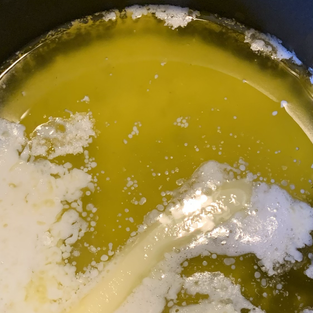Clarified Butter: What, Why, How and When
- Becky
- Mar 11, 2021
- 3 min read

So I had a recipe that called for clarified butter and I'll be honest, I had heard the term and vaguely knew what it looked like, but beyond that, I was unsure. So, I started digging in. And here is the What, the Why, the How and the When of clarified butter.
WHAT
Butter is made up of three major ingredients: milk solids, butter fats and water. It is the milk solids that make the butter burn easily, so separating these three ingredients from each other opens up their uses. If you are a home chef, you should be familiar with clarified butter and its uses. In other countries, clarified butter is also known as ghee, although they are made differently so they are not exactly the same. The clarified butter is the butter fats of normal butter. It typically does not require refrigeration and can last in your room temp kitchen for up to six months.
WHY
Clarified butter (the butter fats) has a higher smoke point than normal butter, and so it makes a great oil for sautéing vegetables of cooking anything on high heat. It's also very low in lactose, so folks with a lactose issue can typically consume clarified butter without issues. Some claim it has great health benefits, but I'm not an expert there so I will leave that to you and Google if you want to know more about that.
HOW
So, with my recipe in hand, I needed two tablespoons of clarified butter. I decided to try making some myself - and it could not have been more simple.
Since my goal was to melt the butter over very low heat until it separated, I used two sticks and a small pot so I could work the layers better. Melting this down over the lowest setting took me about 10 minutes, but I watched as three distinct layers started to form: water, butter fat and milk solids.

After the sticks melted, I began to skim off the top white, foamy part. This is the milk solids. They are not to go to waste, however.
Slow cooked milk solids will begin to brown (this is the "brown butter" you see in many recipes) and they develop a very nutty flavor when cooked over low heat. I took the milk solids I scraped off the top of the melted butter, browned them slowly with a tablespoon of minced garlic, and dished the sauce over oven roasted asparagus (which was delicious, by the way.) Right before serving, I gave a quick squeeze of lemon juice and added a thick pinch of Parmesan cheese and our side dish was complete. (And it looked rocking, too!)

I then started to spoon off the butter fats, or the clarified butter. You can see in the picture, there's still a little bit of milk solids floating on the top, the clarified butter is the liquid gold in the middle, and the layer of white on the bottom of the pan is water.
Some folks boil butter to force the water to evaporate, but I felt like I had more clarified butter than I needed, I only needed 2 tablespoons, so I just scooped it off into a separate container while trying not to disturb the water on the bottom.
I could have then ran the clarified butter through cheesecloth or a fine mesh strainer to strip the last of the milk solids, but I began this whole deal to make Bordelaise sauce, and I wasn't cooking for the Queen, so I didn't sweat it. I let it roll and wasn't disappointed in the end result.

WHEN
So clarified butter does very well in high heats, so its great to use it when frying or sautéing. It's also the go to when dipping seafood such as lobster, clams or crabs.
It is the key ingredient in many sauces, such as Hollandaise and I used it for my demi-glace (which could be a whole separate post entirely!)
It has a very rich taste, and so you will see clarified butter spread all over popcorn (now you know why the "movie theater" butter looks different - it is!) And of course, there's always more!
Clarified butter is not interchangeable with regular butter all the time, especially baking, so don't reach for in place of butter in your cakes and muffins. But it's super easy to make and lasts a long time, so go ahead and make some clarified butter!







Comments